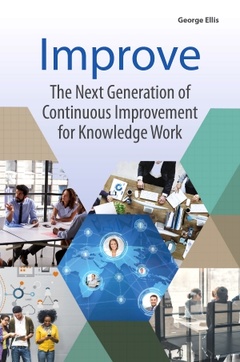Description
Improve
The Next Generation of Continuous Improvement for Knowledge Work
Author: Ellis George
Language: English
Keywords
Action Plan; Customer; Granularity; Helicopter View; Information; Initiative; Knowledge; LOFA; MVP; People; Problem-solving; Process; Product; Project; Solution Blindness; Task; Team; Work
500 p. · 15x22.8 cm · Paperback
Description
/li>Contents
/li>Readership
/li>Biography
/li>Comment
/li>
Improve: The Next Generation of Continuous Improvement for Knowledge Work presents lean thinking for professionals, those who Peter Drucker called knowledge workers. It translates the brilliant insights from Toyota?s factory floor to the desktops of engineers, marketers, attorneys, accountants, doctors, managers, and all those who "think for a living." The Toyota Production System (TPS) was born a century ago to an almost unknown car maker who today is credited with starting the third wave of the Industrial Revolution. TPS principles, better known as lean thinking or continuous improvement, are simple: increase customer value, cut hidden waste, experiment to learn, and respect others. As simple as they are, they are difficult to apply to the professions, probably because of the misconception that knowledge work is wholly non-repetitive. But much of our everyday work does repeat, and in great volume: approvals, problem-solving, project management, hiring, and prioritization are places where huge waste hides. Eliminate waste and you delight customers and clients, increase financial performance, and grow professional job satisfaction, because less waste means more success and more time for expertise and creativity.
This book is a valuable resource for leaders of professional teams who want to improve productivity, quality, and engagement in their organizations.
Foreword xiii
Endorsements xv
Preface xvii
Acknowledgments xxi
1. 30% of what you think is wrong 1
2. A brilliant insight 17
3. Creating value from knowledge work 41
4. The lean equation 51
5. DIMINISH: Recognizing the 8 Wastes of Knowledge Work 65
6. Simplify, engage, and experiment 77
7. Reduce Waste #1: Discord 109
8. Reduce Waste #2: Information Friction 141
9. Reduce Waste #3: More-is-Better Thinking 165
10. Reduce Waste #4: Inertia to Change 207
11. Reduce Waste #5: No-Win Contests 219
12. Reduce Waste #6: Inferior Problem Solving 229
13. Reduce Waste #7: Solution Blindness 253
14. Reduce Waste #8: Hidden Errors 269
15. Standardize workflow 287
16. Workflow improvement cycle 311
17. Workflow—Checklists and expert rule sets 321
18. Workflow—Problem Solve-Select 333
19. Workflow—Visual management for initiatives and projects 345
20. Workflow—Visual management with buffer 367
21. Workflow—Kanban and Kamishibai: Just-In-Time Rationalization 401
22. Workflow—Putting out “fires 427
23. Workflow—Visualizing revenue gaps 439
24. Workflow—Leadership review of knowledge work 451
In 2019, Ellis joined Envista Holdings Corporation, a new spin-off from Danaher for the dental industry, as Vice President of Innovation. There he spends every day immersed in lean knowledge work, deploying, improving, and sustaining new product development workflows in EBS, Envista’s brand of lean knowledge. He also wrote Project Management for Product Development, Control System Design Guide (4th edition), and Observers in Control Systems, all from Elsevier.
- Experience the proven benefits of continuous improvement
- 40%–70% increase in productivity from professionals and experts
- >85% projects on-time
- Reduce lead time by 50%–90%
- Engagement up and voluntary severance cut >50%
- Dozens of simple visual tools that anyone can implement immediately in their existing framework
- All tools and techniques applicable to both face-to-face and virtual meetings
- Easy-to-understand approach: “simplify, engage, experiment
- Presented with deep respect for the experts; no “check the box thinking or overused analogies to the factory floor




